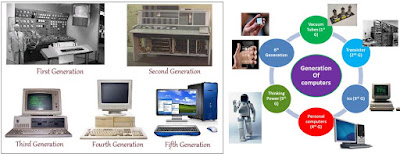First Generation Computer (1946-1959)
The computers produced during the period 1946-1959 with the them technology are regarded as the first generation computer. These computers were manufactured with the vacuum tubes, electronic values, triodes, and diodes etc. as their basic elements. These tubes were used in the arithmetic and logical operations.
Advantages:
- They were capable of making arithmetic and logical operations.
- They used the electronic values in place of the key punch machines or the unit records machines.
Disadvantages:
- They were too big in size very slow, low level of accuracy and reliability.
- They consumed lot of electricity, generated a lot of heat and break down frequently.
- They had very low storage capacity and used machine language.
Second Generation Computers (1959-1965)
The computers produced during the period 1959-1965 with technology are known as second generation computers. These computers used transistors in place of vacuum tubes as their basic elements to perform all computational and logical works.
Advantages:
- They required very small space, were very fast and reliable and dependable.
- They used less power and dissipated less heat and had large storage capacity.
- They used better peripheral devices like card readers and printer etc.
Disadvantages:
- They did not have any operating system and used assembly languages.
- They lacked in intelligence and decision making and needed constant upkeep and maintenance.
- They handled data processing in batch mode only.
Third Generation Computer (1965-1970)
The computers developed during the period 1965-1970 are branded as the third generation computers. The significant features of these computers were that they were built with monolithic integrated circuits each of which consisted of thousands of transistors and other electronic components on a single crystal.
Advantages:
- The size was very small in comparison less costly and built with thousands of transistor which were very cheap.
- They used faster better device for storage called auxiliary backing or secondary storage.
- They used operating system for better resource management and used the concept of time sharing and multiple programming.
Disadvantages:
- They created lot of problems to the manufacturers at their initial stages.
- They lacked thinking power and decision making capability.
- They could not provide any insight into their internal working.
Fourth Generation Computers (1970-1985)
The computer that came to the scene with improved technology during the period 1970-1985 is marked as the fourth generation computers. They used large scale integrated circuits and very large integrated circuits in the form of micro processor in their memory. These computers enlaced millions of transistors and other electronic components on a single silicon chip. A micro processor is a single chip which itself can perform the controlling arithmetic and logical functions of a computer that too at a fast speed.
Advantages:
- They were very small in size and cost of operation was very less.
- They were very compact faster and reliable as they used very large scale integrated circuits.
- They were capable of facilitating the interactive on line remote programming by which one sitting at the distant place can get his programs executed by centrally located computer.
Disadvantages:
- They are less powerful and had less speed than the main frame computers.
- They lacked thinking power and decision making ability.
- They had less storage capacity and needed further improvement.
Fifth Generation Computer (1985):
The computers that are emerging after 1985 with further improved technology are considered as the fifth generation computers. These machines are designed to incorporate “Artificial Intelligence” and used stored reservoirs of knowledge to make expert judgments and decision like human begins. They are also designed to process non numerical information like pictures and graphs using them very large scale integrated circuits.
Advantages:
- They are oriented towards integrated data base development to provide decision models.
- They faster very cheap and have the highest possible storage capacity.
- They have thinking power and decision making capability and thereby they will be able to aid the executives in the management.
Disadvantages:
- They need very low level languages they may replace the human force and cause grievous unemployment problems.
- They may make the human brains dull and doomed.

Amazing, this is great as you want to learn more, I invite to This is my page. computer ram suppliers
ReplyDeleteImekaa pw Sana notice is simple and understandable
ReplyDeleteit would be very usefull for me
ReplyDeleteAdvantages and Disadvantages of Computer
ReplyDeleteWhat were the characteristics of each computer generation, very helpful and valid information
ReplyDelete